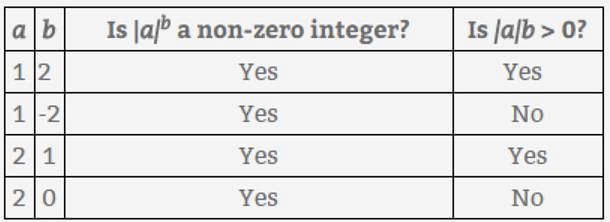GMAT Exam > GMAT Tests > Practice Questions for GMAT > Test: Absolute Values/Modules - GMAT MCQ
Test: Absolute Values/Modules - GMAT MCQ
Test Description
10 Questions MCQ Test Practice Questions for GMAT - Test: Absolute Values/Modules
Test: Absolute Values/Modules for GMAT 2024 is part of Practice Questions for GMAT preparation. The Test: Absolute Values/Modules questions and answers have been
prepared according to the GMAT exam syllabus.The Test: Absolute Values/Modules MCQs are made for GMAT 2024 Exam. Find important
definitions, questions, notes, meanings, examples, exercises, MCQs and online tests for Test: Absolute Values/Modules below.
Solutions of Test: Absolute Values/Modules questions in English are available as part of our Practice Questions for GMAT for GMAT & Test: Absolute Values/Modules solutions in
Hindi for Practice Questions for GMAT course. Download more important topics, notes, lectures and mock
test series for GMAT Exam by signing up for free. Attempt Test: Absolute Values/Modules | 10 questions in 20 minutes | Mock test for GMAT preparation | Free important questions MCQ to study Practice Questions for GMAT for GMAT Exam | Download free PDF with solutions
Detailed Solution for Test: Absolute Values/Modules - Question 1
Test: Absolute Values/Modules - Question 2
What is the value of x?
(1) 4 < x < 6
(2) |x| = 4x − 15
(2) |x| = 4x − 15
Detailed Solution for Test: Absolute Values/Modules - Question 2
| 1 Crore+ students have signed up on EduRev. Have you? Download the App |
Detailed Solution for Test: Absolute Values/Modules - Question 3
Detailed Solution for Test: Absolute Values/Modules - Question 4
Test: Absolute Values/Modules - Question 5
If a is a negative integer, is |a| + |b| an even integer?
(1) xa * xb = 1
(2) a ≠ - 1
Detailed Solution for Test: Absolute Values/Modules - Question 5
Detailed Solution for Test: Absolute Values/Modules - Question 6
Test: Absolute Values/Modules - Question 7
If a and b are integers, and a not= b, is |a|b > 0?
(1) |ab| > 0
(2) |a|b is a non-zero integer
Detailed Solution for Test: Absolute Values/Modules - Question 7
Test: Absolute Values/Modules - Question 8
If a = |b - 6| + |b + 2|, what is the value of a?
(1) a is an integer greater than 7
(2) -2 < b < 6
Detailed Solution for Test: Absolute Values/Modules - Question 8
Test: Absolute Values/Modules - Question 9
If a, b and x are integers such that a6 = b3 = |x|/x, what is the value of a - b ?
(1) a3*b7 > 0
(2) a + b > 0
Detailed Solution for Test: Absolute Values/Modules - Question 9
Detailed Solution for Test: Absolute Values/Modules - Question 10
|
18 docs|139 tests
|
Information about Test: Absolute Values/Modules Page
In this test you can find the Exam questions for Test: Absolute Values/Modules solved & explained in the simplest way possible.
Besides giving Questions and answers for Test: Absolute Values/Modules, EduRev gives you an ample number of Online tests for practice


















